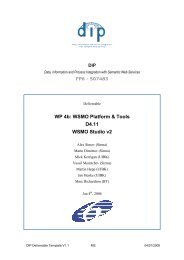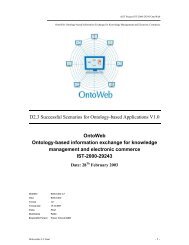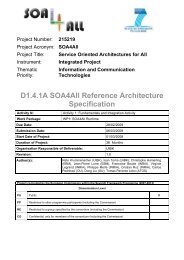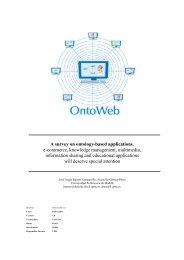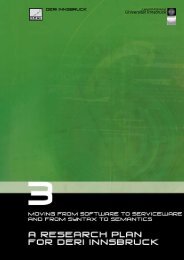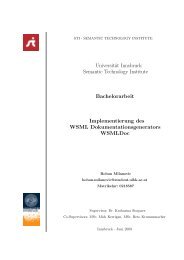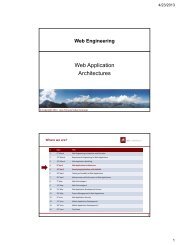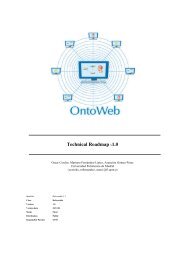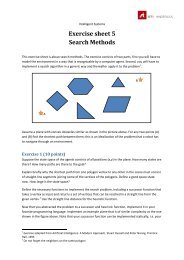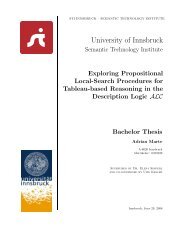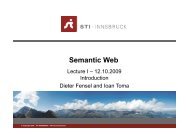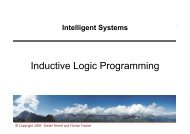D7 â Dynamic Ontology Management System (Design) - STI Innsbruck
D7 â Dynamic Ontology Management System (Design) - STI Innsbruck
D7 â Dynamic Ontology Management System (Design) - STI Innsbruck
Create successful ePaper yourself
Turn your PDF publications into a flip-book with our unique Google optimized e-Paper software.
D07_01_DOMS_F01<br />
4. A PROTOTYPE MULTI-AGENT INFORMATION SEARCH SYSTEM<br />
4.1 INTRODUCTION<br />
The system to be described helps the user in the search for information on a specific domain. Its<br />
objective is to avoid as much as possible the two main problems of keyword based web search,<br />
namely that some of the retrieved documents are irrelevant, and that some of the relevant documents<br />
may not be retrieved. These problems derive from the nature of keyword based search and from the<br />
lack of structure in the searched documents.<br />
It has been identified previously that ontologies can improve the accuracy of web searches because<br />
the search program can look for web pages that refer to a precise concept (in context and with detailed<br />
information) [Kokossis&Bañares-Alcantara, 2003]. The prototype system involves several<br />
ontologies:<br />
• a domain ontology (an input from the user), providing the initial information about the domain of<br />
search,<br />
• a set of query ontologies (intermediates), resulting from partitioning the domain ontology into<br />
smaller (more specific) ontologies,<br />
• a set of response ontologies (intermediates), consisting of the information found during the search<br />
(one response ontology is created per each query ontology), and<br />
• an information ontology (an output from the system), which is the result of merging the response<br />
ontologies.<br />
All of them are implemented in RDF (Resource Description Framework, http://www.w3.org/RDF)<br />
which is becoming the de facto standard for the representation of ontologies [Fensel, 2001]. The<br />
domain ontologies were generated with two well known graphical ontology editors, OntoEdit<br />
(http://www.ontoprise.de/ontoedit.htm) and Protégé-2000 (http://protege.stanford.edu/index.html).<br />
4.2 MULTI-AGENT SYSTEM ARCHITECTURE<br />
Figure 10 depicts the Multi-Agent <strong>System</strong> architecture.<br />
Figure 10: Multi-Agent Search <strong>System</strong> Architecture<br />
IST-2001-33174 © h-TechSight Consortium October 2002 Page 18 of 27



